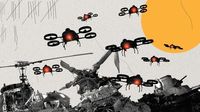On a clear morning at Camp Atterbury, Indiana, a new chapter in modern warfare unfolded before the eyes of U.S. military officials and international observers. Instead of the thunderous booms and streaking missiles that usually define air defense demonstrations, silence reigned as a swarm of 49 drones suddenly fell from the sky—brought down by an invisible force. The culprit? Leonidas, a high-powered microwave (HPM) weapon developed by California-based defense contractor Epirus. The event, held on August 27 and again on August 29, 2025, marked what Epirus CEO Andy Lowery boldly described as a "singularity event," a turning point in counter-drone technology that could reshape both battlefield tactics and domestic security measures.
According to Axios, which was the only media outlet present for the demonstration, the two-hour show climaxed with Leonidas facing its largest-ever challenge: a coordinated swarm of 49 quadcopters. The system, which weaponizes electromagnetic interference, disabled every drone simultaneously. There were no fiery explosions, no telltale trails of smoke—just a sudden, collective descent of the drones as their electronics were quietly and efficiently neutralized. As Lowery put it to Axios, "I call this a singularity event."
So, what makes Leonidas so different from previous counter-drone systems? Traditional defenses rely on projectiles or lasers, each with their own limitations. Projectiles can miss or run out, while lasers must focus on one target at a time and require sustained accuracy. Microwaves, on the other hand, offer something entirely new: the ability to strike multiple targets at once, with speed and silence. The Leonidas system uses gallium nitride technology to generate finely tunable pulses of electromagnetic energy, allowing operators to adjust the beam’s intensity and spread depending on the size and density of a drone formation. Each unit resembles a mobile radar system mounted on a vehicle, making it both deployable and flexible on the battlefield.
This demonstration was part of the U.S. Army’s Indirect Fire Protection Capability-High Power Microwave (IFPC-HPM) program. Epirus has already delivered four Leonidas prototypes under a $66 million contract, BBC reports. The company, founded in 2018, has not only worked with the Army but also with the Navy and Marine Corps, and has tested its technology in multiple overseas theaters. The recent test at Camp Atterbury is considered one of the most significant real-world demonstrations of HPM technology to date, underscoring the growing urgency to find effective defenses against the proliferation of inexpensive, networked drones in conflicts from Ukraine to the Middle East.
The implications of Leonidas’ successful test are far-reaching. As Axios points out, drone swarms are a nightmare for security officials around the globe. They have been used to overwhelm Russian air bases and have even caused chaos near American airports. The lines between missile and unmanned are blurring, and traditional armored vehicles or entrenched positions are no longer safe havens. The rise of cheap, easily deployable drones is challenging the very foundations of military strategy and spending.
Domestically, the threat is just as real. The Northeast experienced a surge of drone activity late last year, revealing how ill-prepared the U.S. remains for a true overhead incursion. It’s not just military installations that are at risk—critical infrastructure like power plants, ports, and even stadiums hosting major events such as the World Cup could become targets. Recognizing this, Lowery recently met with Homeland Security Secretary Kristi Noem to discuss the need for platforms like Leonidas at key domestic sites. "This platform is going to be needed at stadiums and at ports and at airports," Lowery told Axios. "The list goes on and on."
Epirus is not resting on its laurels. In March 2025, the company announced a $250 million funding round led by 8VC and Washington Harbour Partners LP, aimed at accelerating development and deployment. More recently, Epirus unveiled its "sixth domain" doctrine, arguing that the sheer number of cheap, networked, and dangerous machines now challenges the traditional dividing lines of war. The five established domains—air, land, sea, space, and cyber—must now contend with this new, rapidly evolving threat environment.
During the Camp Atterbury demonstration, observers from various branches of the U.S. military as well as foreign partners, including some from the Indo-Pacific region, watched as Leonidas dispatched the drone swarm with a single, invisible strike. The event underscored not only the system’s technical prowess but also the changing nature of warfare itself. As BBC notes, while Leonidas remains in the testing phase, its ability to neutralize swarms without ammunition, smoke, or explosions could fundamentally alter the calculus of air defense. It’s a leap forward that raises new questions about cost effectiveness, escalation, and the potential for countermeasures.
Epirus’ approach is also notable for its adaptability. Operators can control the Leonidas beam through software, adjusting it in real time to deal with different types of drone threats—whether it’s a small formation or a massive swarm. This flexibility is crucial as adversaries continue to innovate, finding new ways to coordinate and deploy unmanned aerial vehicles. The company’s commitment to staying in what Lowery calls the "one-to-many fight" suggests that future versions of Leonidas may incorporate sensing, electronic warfare, and even cyber capabilities.
The demonstration at Camp Atterbury is more than a technical milestone; it’s a wake-up call for both military planners and civilian security officials. As the world becomes increasingly reliant on electronic systems, the ability to disable enemy technology without collateral damage or costly munitions is an enticing prospect. But with every leap forward comes new challenges—how to defend against similar attacks, how to integrate these systems into existing defense networks, and how to ensure that the technology doesn’t fall into the wrong hands.
For now, Leonidas stands as a symbol of what’s possible when innovation meets necessity. The sight of nearly 50 drones dropping from the sky in unison—without a single shot fired—may soon become the new standard in both military and civilian defense. As Epirus continues to refine its technology and expand its reach, the balance of power in the skies is shifting, one silent pulse at a time.
